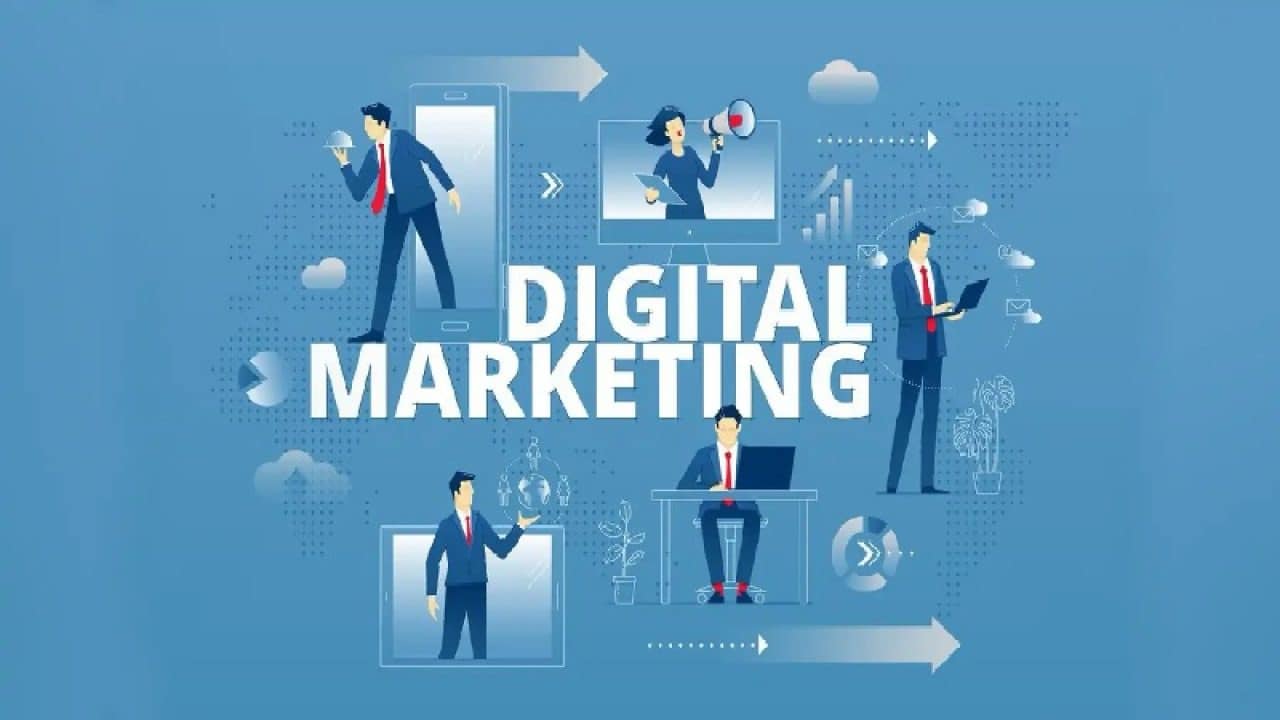If you or your company invest in online ads, you may have heard complaints about how programmatic advertising and the Internet of Things are hurting digital marketing. Programmatic advertising has been used to define the most recent marketing trend. Your advertisement will only be successful if the right people see it. Even if you’ve been nodding along, you may not have fully understood why programmatic advertising is being called a game-changer until now. In this article, we will discuss programmatic advertising platforms, examples, and their benefits.
What Is Programmatic Advertising?
The practice of buying and selling advertising space in real-time through an electronic bidding system is called “programmatic advertising.” However, using a complex network, advertisers can buy ad impressions on publisher sites or applications using programmatic advertising. DOOH (digital out-of-home) commercials, as well as internet, streaming, TV, video, and voice ads, are all part of programmatic advertising.
Also, it started out as a way to use scraps as much as possible, but it has grown into something much more complicated.
A common misconception holds that all programmatic advertising takes place in real-time. That’s a special case of programmatic, specifically a way to use programmed methods for making immediate purchases. You can think of it as akin to having a robot do your eBay shopping for you. In contrast to the auction model of real-time advertising, which is called “programmatic” and includes all kinds of automation, automation is only based on criteria that have already been set.
The offline method of advertising is inefficient because advertisers and publishers waste time and money on paperwork, RFPs, and haggling. The main problem with the traditional approach is that you can’t figure out your return on investment (ROI).
Programmatic advertising, on the other hand, is a complicated system that uses fewer people and more software to reach this goal and show ads all over the web.
Understanding Programmatic Advertising
It can be hard to understand how the different parts of the programmatic advertising ecosystem work together, but you may already know words like demand-side platform (DSP), supply-side platform (SSP), and middleman. Ad networks, ad servers, ad exchanges, and data management platforms all fall under the umbrella term “ad tech,” which launches a new tab or window. What do they signify, and how exactly does programmatic advertising function?
In programmatic advertising, a computer algorithm deals with the sale of ad space on the platforms of content providers. Artificial intelligence (AI)-powered algorithms evaluate each user based on their actions, demographic information, and cookie data, among other things, to decide which ad should be shown to them.
Digital advertising also uses demand-side platforms (DSPs) and data management platforms (DMPs) to help advertisers better manage and analyze the huge amounts of user data they have access to (brands can combine first-party and third-party data to improve targeting). Publishers often employ the services of an SSP to manage their ad stock. SSPs take bids into account when deciding where to place ads.
What Are the Types of Programmatic Advertising
For programmatic advertising to work, advertisers and publishers might not have to work together directly. This is not the standard procedure for purchasing media. The method of ad distribution depends on the programmatic agreement selected. Publishers use a variety of programmatic partnerships to spread ads across their platforms and reach their target audiences. Here are the types of programmatic advertising:
#1. Real-Time Bidding (RTB)
Most programmatic ad purchases now take place through real-time bidding (RTB). An auction system that works on the idea of bidding makes it possible to buy and sell ads in real-time. Because the ad exchange platform “opens” the auction to the public, RTB, which allows an ad network to place a bid on any site, is also known by the terms “open marketplace,” “open auction,” and “open exchange.”
As soon as a user loads a webpage, an SSP makes publisher ad spots available. Advertisers submit bids, and the highest bidder takes the prize. Website users will see the winning advertisement in the designated spot. Using cutting-edge real estate technology, it functions at peak efficiency in real-time. This allows for faster and more efficient delivery of advertising impressions.
- Advantage: The RTB system allows for more accurate pricing. Because the auction begins when a new visitor arrives, bloggers also enjoy a higher fill rate.
- Disadvantage: Advertisers may want to shift more of their budgets to other programmatic arrangements because of the lack of transparency. Additionally, publishers have no idea who is bidding on their ad space.
#2. Private Marketplace (PMP)
The private marketplace works like RTB, except that advertisers can only use it if they are invited to do so. Publishers usually save some of their best ad space for a small group of advertisers during a closed or private auction. Most DSPs offer their own management portals (PMPs), which can only be accessed by the DSP’s users and clients.
Because of the many advantages it provides, PMPs are typically employed by large-scale websites and magazines. When using a PMP, advertisers are aware of exactly which websites their advertisements are being shown on, as opposed to RTB’s blanket approach.
- Advantage: Advertisements on publishers’ sites are better specific and pay out handsomely. In addition, publishers are notoriously selective in terms of the authors they sign on to.
- Disadvantage: For publishers, getting into PMP auctions is just as difficult.
#3. Preferred Deals
A preferred deal is when a publisher sets aside ad space for a certain advertiser. Based on audience data and website metrics, the advertiser and publisher will come to a deal that is good for both of them. That is to say, advertisers are given “first dibs” on popular content and targeted viewers. Plus, publishers can choose which advertisers to work with, which can help them make more money. Deals are set at a certain price or cost per unit.
In contrast to other programmatic deals, this one doesn’t guarantee that the advertiser will bid on the ad unit. Non-guaranteed programmatic deals, unreserved fixed-rate purchases, and “spot” transactions are all terms used to describe preferred deals.
Furthermore, when a person opens a web page, a request is sent to the advertising network for an ad to be displayed on the page. The network has the first option to either purchase the ad space at the agreed-upon price or decline the request. If the advertisers decline, the system will automatically place the ad space up for auction.
- Advantage: Successful publishers can partner with reputable marketers and earn top dollar for their content.
- Disadvantage: Bloggers with a large number of followers tend to receive the best deals.
#4. Programmatic Guaranteed
For media buyers, the tried-and-true method of programmatic guaranteed (sometimes called programmatic direct or automated guaranteed) is the way to go. In this scenario, the advertiser and the publisher work out the details between themselves.
Programmatic direct is different from the other ways we looked into buying media because there is no bidding process. After the two parties have negotiated, the inventory is sold straight to the advertiser. Because of programmatic guarantees, advertisers have more choices when it comes to ad inventory, pricing, targeting specific groups of people, and setting limits on how often ads can be shown.
Automated guarantees are used by advertisers who know where to place their ads well and have a large budget.
- Advantage: An abundance of high-quality advertising options at affordable pricing is at a blogger’s disposal.
- Disadvantage: It’s difficult to break in since you require a really well-performing website.
Are Google Ads Programmatic?
Google Ads gives you access to Google’s vast website database. Contrarily, programmatic advertising isn’t restricted to a single medium. It lets you use Google Ads and ads from other ad exchanges, like AdForm, AppNexus, the Rubicon Project, and even Amazon.
Programmatic Advertising Examples
From these examples of programmatic advertising, you may learn how companies like Google and nonprofits like the Amanda Foundation create effective and engaging programmatic ads. See how the experts do it and learn from their mistakes as you craft your own successful programmatic advertising campaigns. Here are the top five examples of programmatic advertising:
#1. The Economist
The investment made in The Economist’s award-winning campaign paid off handsomely.
The ads used Economist content and provocative, clever, or funny headlines to attract people who hadn’t spent much time on the Economist website, based on their browser cookies. However, the outcomes were really satisfying. Their campaign ROI was 10:1 on a $1.2 million media investment, and they attracted 650,000 new prospects and inspired 3.6 million to take action, as reported.
This is in addition to a 64% increase in awareness and a 22% increase in consideration in the US, which is an amazing feat by anyone’s standards.
#2. Google
To improve the efficiency of its advertising operations, Google started using programmatic marketing in 2014. The company wanted to make its digital advertising more effective, and it realized that programmatic advertising could help it do that.
The Google Search app was the primary target of Google’s programmatic advertising campaign.
Google was also able to focus on its most valuable customers because it used both first-party and third-party data to target its ads. In addition, they also used this feature to improve their marketing efforts right away by using campaign data to come up with better ways to do things.
#3. AirAsia
AirAsia started a Facebook advertising effort to boost brand awareness and ticket sales. Regular AirAsia flyers were the target audience for this promotional push. People who have flown with AirAsia since a plane tragedy in 2014 were also targets.
Ads featuring new and varied artwork were sent to each distinct demographic.
AirAsia customers who flew with them often saw an ad for special prices on their most popular routes. In contrast, passengers who had recently looked for flights on AirAsia or who had traveled with the airline were shown a comedic video produced by AirAsia or a discount on their next flight. Also, read CPA MARKETING NETWORK: 20 Best Networks With High Offers.
#4. IHG
Holiday Inn and Intercontinental’s parent company, IHG, started using programmatic advertising to get people to book on their sites instead of on aggregators like Expedia and Booking.com.
However, with some travel booking platforms taking as much as 24% in commissions, hotels can really benefit from increased direct spending.
Customers who were considering making a reservation were the focus of IHG’s programmatic ads, which offered a “book direct price” option. According to research, they can reach more people who are likely to be interested in our book-direct message by using programmatic’s refined targeting skills to locate more people who are actively searching for lodging. Except for surge marketing, which has proven quite effective, spending a lot of money on internet banner ads has had zero impact.
#5. Amanda Foundation
The nonprofit Amanda Foundation started using programmatic marketing to make it more likely that cats and dogs in the shelter will be adopted. However, they had a problem: how to get their advertisements in front of the proper people.
Also, the Amanda Foundation knew that some people like dogs better than cats, and others like dogs better than kittens. They also knew that some people like different kinds of dogs. If you’re older and have less of an active lifestyle than you once did, you might like having a dog with less of a need for exercise.
The Amanda Foundation could serve as a matchmaker by using programmatic advertising. In addition, the organization did thorough audience targeting to figure out who would be most interested in getting a pet and what kind of pet they would like.
Are Social Media Ads Programmatic?
Yes, social media ads are programmatic. But with programmatic social advertising, marketers can keep full control over how much they spend on ads and reach a very specific or very broad audience. You will be able to see how well your social media campaigns are doing and figure out what works best.
Programmatic Advertising Platforms
Programmatic advertising platforms are easy to use and work well for both publishers and advertisers. They help publishers make the most money from ads by auctioning off ad space to millions of advertisers all over the world. This means that marketers can reach more people and use data to zero in on specific demographics. Here are the top four programmatic advertising platforms:
#1. MediaMath
More than 3,500 clients use MediaMath’s full-service campaign management and omnichannel advertising solutions.
The audience feature of MediaMath is very helpful because it makes good use of data integration, which lets advertisers target their most important customers. With advertising options like display, native, video, audio, and digital out-of-home, everything is taken care of.
In addition, MediaMath provides exceptional service and assistance to help clients maximize their campaigns.
#2. Adobe Advertising Cloud
Adobe is a well-known company that makes software, and its Adobe Advertising Cloud is one of the best platforms for programmatic advertising.
It gives marketers a complete solution by specializing in many different types of ads, such as linked TV, video, display, native, audio, and search campaigns. This technology is great at managing inventory and doing targeted marketing, so use it to make the most money possible.
Although it may take some time to get used to the UI, the platform is excellent for increasing ROI.
#3. Lotame
Lotame’s main job is to act as an ad exchange, which makes it easier for marketers and customers to talk to each other across devices and platforms like mobile CTV and web browsers.
It gives valuable data for onboarding, analysis, and segmentation modeling, and it also has great tools for managing your audience. By buying publisher-improved audience groups, ad networks can reach more people with their campaigns.
Lotame’s main selling point for modern businesses is that it will still work even if there are no cookies.
#4. SmartyAds
SmartyAds’ programmatic advertising platform gives both advertisers and publishers a wide range of tools. The main goal of the platform is to make advertising easier so that businesses can give top priority to their best trading partners.
This solution makes it easier for publishers and advertisers to get more clicks, conversions, yields, fill rates, and users to interact with their ads.
SmartyAds is a top choice for both advertisers and publishers, with over 500 million monthly impressions in North America alone.
Is SEO Programmatic Advertising?
Yes, you could be forgiven for thinking that search engine optimization (SEO) and programmatic advertising are two distinct forms of digital marketing. But there are many things that can be learned from SEO work that can be used to make programmatic advertising more effective.
Programmatic Advertising Benefits
A marketer’s toolkit today would be incomplete without programmatic advertising.
The need for programmatic advertising will rise as more and more advertisers shift their focus to digital channels as the major means of reaching their target audiences and as more and more advertisers seek out ways to streamline the process of purchasing and selling digital advertisements. Here are the top benefits of programmatic advertising:
#1. Modular and Adjustable Budgeting
Since the amount of money spent on programmatic advertising strategies is fully flexible, they are suitable for businesses of all sizes.
Businesses with smaller marketing budgets might set a maximum campaign budget to make sure they don’t spend more than they planned.
Google Ads lets users set average daily budgets and choose how to spend the money each day to maximize ROI. For instance, a restaurant’s display campaign may profit from spending more in the days leading up to the weekend.
Programmatic advertising is flexible, so businesses can spend more or less as necessary, and budgets can be spent more intelligently.
#2. Leveraging Both Internal and External Data
The variety of data segments available to advertisers is another perk of programmatic advertising. For example, advertisers can upload their own first-party data in a safe way and then use real-time bidding signals to target only those people.
Further, if an advertiser doesn’t have access to first-party data, a DSP will likely have various third-party categories from which to choose as a targeting option. Creating lookalike audiences of their existing consumers is another type of third-party data that marketers may use to their advantage.
Using this method, you can reach out to people who have similar tastes to your current clientele.
#3. Transparency
Programmatic advertising is more open because it lets advertisers see everything about their campaigns. Advertisers can watch where their ads appear online, who views them, and how much they make.
Because of this, it is much easier for marketers to figure out how well their efforts are working and come up with ways to improve them, like finding popular sites that their target audience visits often.
#4. Real-Time Data and Analysis
Since programmatic advertising is based on using and analyzing data at the moment, marketers can get this information in real-time.
So, they can make quick decisions as campaigns come out, allowing for real-time changes and evaluations of how well campaigns work. Programmatic advertising stands out as a helpful solution since it allows for real-time management through a data-driven decision-making process.
#5. Tackle Ad Frauds Effectively
There is a problem with unethical advertising techniques in the internet advertising sector. For a long time, publishers have been using dishonest strategies to deceive advertisers.
Because programmatic advertising platforms are open, businesses can compare how well ads from different publishers perform so they can select the best ones.
Also, major programmatic advertising platforms fight ad fraud by blocking fraudulent practices like fake bot traffic and pre-rolls and paying advertisers for any fraudulent practices that do get through. This is one of the best benefits of programmatic advertising.
Conclusion
Learn the basics and benefits of programmatic advertising so you can improve your current programmatic strategy or make a new one that uses it. You can’t expect your software to be successful if you don’t take the time to learn about the many features and functions of each platform.
In today’s advertising world, digital advertising platforms can’t be ignored. By connecting publishers and sellers, they facilitate real-time bidding for advertising space.
Programmatic Advertising FAQs
What is SEO?
SEO is a broad term for a number of ways to make a website more visible in unpaid search results. SEO is crucial since online searches are increasingly used to find all sorts of things. An effective SEO campaign will bring in not just more, but also better visitors to your website.
What is the difference between PPC and programmatic?
By using programmatic advertising, a digital marketer can speed up the time it takes to buy and show online ads. With pay-per-click advertising, you may tailor your search ads to specific age ranges and genders.
Is Facebook programmatic advertising?
Yes, programmatic advertising is one of the examples that can also take the shape of Facebook adverts.
Similar Articles
- Government Grants (Detailed Guide)
- Amazon Affiliate Marketing: All You should Know and How to Earn
- EBAY BIDDING: Rules, Bots, How it Works & How to Win (+ Quick Tools)
- BEST AFFILIATE MARKETING GUIDE TO EARN FROM (SIMPLIFIED)
- REBRANDING: Meaning, Examples, Ideas & Strategy






